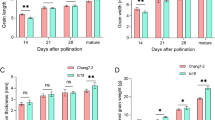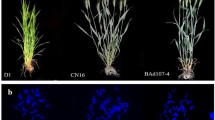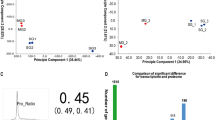Abstract
To understand the molecular changes taking place during the early grain development in common wheat, we profiled transcriptome and proteome of two cultivars, “P271” and “Chinese Spring” (CS) with large and small grains, respectively. More than 85,000 genes and 7500 proteins were identified to express during early grain development in two wheat cultivars. We observed enrichment in the number of genes falling in the functional categories—carbohydrate metabolism, amino acid metabolism, lipid metabolism, and cofactor as well as vitamin metabolism with progression in grain development, which indicates towards the importance of these metabolic pathways during grain maturation. Many genes showed inconsistency between transcription and translation, which suggested a role of post-transcriptional events that determine the fate of nascent transcript/protein, in the early grain development. In silico localization of differentially expressed genes/proteins between CS and P271 to wheat chromosomes, exhibited a biased genomic distribution with chromosomes 1A, 4B, and 5B contributing primarily to it. These results corroborated the earlier findings, where chromosomes 1A, 4B, and 5B were reported to harbor genes/QTLs for yield contributing traits such as grain length and thickness. Collectively, this study reveals the molecular changes taking place during early grain development, through light on the regulation of these processes, and allows identification of the gene candidates contributing to the contrasting grain characteristics of CS and P721. This information has implications in the future wheat breeding for the enhanced grain yield.






Similar content being viewed by others
References
Altenbach SB, Vensel WH, Dupont FM (2011) The spectrum of low molecular weight alpha-amylase/protease inhibitor genes expressed in the US bread wheat Butte 86. BMC Res Notes 4:242
Bancel E, Bonnot T, Davanture M, Branlard G, Zivy M, Martre P (2015) Proteomic approach to identify nuclear proteins in wheat grain. J Proteome Res 14:4432–4439
Benjamini Y, Hochberg Y (1995) Controlling the false discovery rate: a practical and powerful approach to multiple testing. J R Stat Soc B 57:289–300
Cabral AL, Jordan MC, Larson G, Somers DJ, Humphreys DG, McCartney CA (2018) Relationship between QTL for grain shape, grain weight, test weight, milling yield, and plant height in the spring wheat cross RL4452/‘AC Domain'. PLoS ONE 13:e0190681
Cao R, Guo L, Ma M, Zhang W, Liu X, Zhao H (2019) Identification and functional characterization of squamosa promoter binding protein-like gene TaSPL16 in wheat (Triticum aestivum L.). Front Plant Sci 10:212
Chi Q, Guo L, Ma M, Zhang LJ, Mao HD, Wu BW, Liu XL, Ramirez-Gonzalez RH, Uauy C, Appels R, Zhao HX (2019) Global transcriptome analysis uncovers the gene co-expression regulation network and key genes involved in grain development of wheat (Triticum aestivum L.). Funct Integr Genomic. https://doi.org/10.1007/s10142-019-00678-z
Dupont FM, Vensel WH, Tanaka CK, Hurkman WJ, Altenbach SB (2011) Deciphering the complexities of the wheat flour proteome using quantitative two-dimensional electrophoresis, three proteases and tandem mass spectrometry. Proteome Sci 9:10
Ernst J, Bar-Joseph Z (2006) STEM: a tool for the analysis of short time series gene expression data. BMC Bioinformatics 7(1):191
Gao LY, Wang AL, Li XH, Dong K, Wang K, Appels R, Ma WJ, Yan YM (2009) Wheat quality related differential expressions of albumins and globulins revealedd by two-dimensinoal difference gel electrophoresis (2-D DIGE). J Proteomics 73: 279-296
Ge P, Hao P, Cao M, Guo G, Lv D, Subburaj S, Li X, Yan X, Xiao J, Ma W, Yan Y (2013) iTRAQ-based quantitative proteomic analysis reveals new metabolic pathways of wheat seedling growth under hydrogen peroxide stress. Proteomics 13:3046–3058
Gegas VC, Nazari A, Griffiths S, Simmonds J, Fish L, Orford S, Sayers L, Doonan JH, Snape JW (2010) A genetic framework for grain size and shape variation in wheat. Plant Cell 22:1046–1056
Gu A, Hao P, Lv D, Zhen S, Bian Y, Ma C, Xu Y, Zhang W, Yan Y (2015) Integrated proteome analysis of the wheat embryo and endosperm reveals central metabolic changes involved in the water deficit response during grain development. J Agric Food Chem 63:8478–8487
Guo G, Ge P, Ma C, Li X, Lv D, Wang S, Ma W, Yan Y (2012) Comparative proteomic analysis of salt response proteins in seedling roots of two wheat varieties. J Proteome 75:1867–1885
Gupta PK, Rustgi S, Kumar N (2006) Genetic and molecular basis of grain size and grain number and its relevance to grain productivity in higher plants. Genome 49:565–571
Hu GJ, Koh J, Yoo MJ, Grupp K, Chen S, Wendel JF (2013) Proteomic profiling of developing cotton fibers from wild and domesticated Gossypium barbadense. New Phytol 200:570–582
Jia H, Wang Y, Sun M, Li B, Han Y, Zhao Y, Li X, Ding N, Li C, Ji W, Jia W (2013) Sucrose functions as a signal involved in the regulation of strawberry fruit development and ripening. New Phytol 198:453–465
Juhász A, Moolhuijzen P, Bellgard M, Appels R, Békés F (2012) Wheat grain proteomics for the food industry. In: Toldrá F, Nollet LML (eds) Proteomics in Foods. Springer, pp 341–377
Kanehisa M, Goto S, Sato Y, Furumichi M, Tanabe M (2012) KEGG for integration and interpretation of large-scale molecular data sets. Nucleic Acids Res 40:109–114
Kumar RR, Singh K, Ahuja S, Tasleem M, Singh I, Kumar S, Grover M, Mishra D, Rai GK, Goswami S, Singh GP, Chinnusamy V, Rai A, Praveen S (2019) Quantitative proteomic analysis reveals novel stress-associated active proteins (SAAPs) and pathways involved in modulating tolerance of wheat under terminal heat. Funct Integr Genomics 19:329–348
Laudencia-Chingcuanco DL, Stamova BS, Lazo GR, Cui X, Anderson OD (2006) Analysis of the wheat endosperm transcriptome. J Appl Genet 47:287–302
Laudencia-Chingcuanco DL, Stamova BS, You FM, Lazo GR, Beckles DM, Anderson OD (2007) Transcriptional profiling of wheat caryopsis development using cDNA microarrays. Plant Mol Biol 63:651–668
Ma C, Zhou J, Chen G, Bian Y, Lv D, Li X, Wang Z, Yan Y (2014) iTRAQ-based quantitative proteome and phosphoprotein characterization reveals the central metabolism changes involved in wheat grain development. BMC Genomics 15:1029
Mak Y, Skylas DJ, Willows R, Connolly A, Cordwell SJ, Wrigley CW, Sharp PJ, Copeland L (2006) A proteomic approach to the identification and characterisation of protein composition in wheat germ. Funct Integr Genomics 6:322–337
Nadaud I, Tasleemtahir A, Chateigner-Boutin AL, Chambon C, Viala D, Branlard G (2015) Proteome evolution of wheat (Triticum aestivum L.) aleurone layer at fifteen stages of grain development. J Proteome 123:29–41
Nadolska-Orczyk A, Rajchel IK, Orczyk W, Gasparis S (2017) Major genes determining yield-related traits in wheat and barley. Theor Appl Genet 130:1081–1098
Olsen OA (2004) Nuclear endosperm development in cereals and Arabidopsis Thaliana. Plant Cell 16:S214–S227
Pechanova O, Takac T, Samaj J, Pechan T (2013) Maize proteomics: an insight into the biology of an important cereal crop. Proteomics 13:637–662
Peng J, Richards DE, Hartley NM, Murphy GP, Devos KM, Flintham JE, Beales J, Fish LJ, Worland AJ, Pelica F, Sudhakar D, Christou P, Snape JW, Gale MD, Harberd NP (1999) Green revolution’ genes encode mutant gibberellin response modulators. Nature 400:256–261
Peng Z, Wan M, Li F, Lv H, Li C, Xia G (2009) A proteomic study of the response to salinity and drought stress in an introgression strain of bread wheat. Mol Cell Proteomics 8:2676–2686
Pfeifer M, Kugler KG, Sandve SR, Zhan B, Rudi H, Hvidsten TR, International Wheat Genome Sequencing Consortium, Mayer KF, Olsen OA (2014) Genome interplay in the grain transcriptome of hexaploid bread wheat. Science 345:1250091
Ponnala L, Wang Y, Sun Q, van Wijk KJ (2014) Correlation of mRNA and protein abundance in the developing maize leaf. Plant J 78:424–440
Ramírez-González RH, Borrill P, Lang D, Harrington SA, Brinton J, Venturini L, Davey M, Jacobs J, van Ex F, Pasha A, Khedikar Y, Robinson SJ, Cory AT, Florio T, Concia L, Juery C, Schoonbeek H, Steuernagel B, Xiang D, Ridout CJ, Chalhoub B, KFX M, Benhamed M, Latrasse D, Bendahmane A, International wheat genome sequencing consortium, Wulff BBH, Appels R, Tiwari V, Datla R, Choulet F, Pozniak CJ, Provart NJ, Sharpe AG, Paux E, Spannagl M, Bräutigam A, Uauy C (2018) The transcriptional landscape of polyploid wheat. Science 361:eaar6089
Rangan P, Furtado A, Henry RJ (2017) The transcriptome of the developing grain: a resource for understanding seed development and the molecular control of the functional and nutritional properties of wheat. BMC Genomics 18:766
Rustgi S, Shafqat MN, Kumar N, Baenziger PS, Ali ML, Dweikat I, Campbell BT, Gill KS (2013) Genetic dissection of yield and its component traits using high-density composite map of wheat chromosome 3A: bridging gaps between QTLs and underlying genes. PLoS ONE 8:e70526
Sakuma S, Golan G, Guo Z, Ogawa T, Tagiri A, Sugimoto K, Bernhardt N, Brassac J, Mascher M, Hensel G, Ohnishi S, Jinno H, Yamashita Y, Ayalon I, Peleg Z, Schnurbusch T, Komatsuda T (2019) Unleashing floret fertility in wheat through the mutation of a homeobox gene. Proc Natl Acad Sci USA 116:5182–5187. https://doi.org/10.1073/pnas.1815465116
Shewry PR, Mitchell RAC, Tosi P, Wan Y, Underwood C, Lovegrove A, Freeman J, Toole GA, Mills ENC, Ward JL (2012) An integrated study of grain development of wheat (cv. Hereward). J Cereal Sci 56:21–30
Skylas DJ, Van Dykc D, Wrigley CW (2005) Proteomics of wheat grain. J Cereal Sci 41:165–179
Su Z, Hao C, Wang L, Dong Y, Zhang X (2011) Identification and development of a functional marker of TaGW2 associated with grain weight in bread wheat (Triticum aestivum L.). Theor Appl Genet 122:211–223
Tang YW, Zeng XQ, Wang YL, Bai LJ, Xu QJ, Wei ZX, Yuan HJ, Nyima T (2017) Transcriptomics analysis of hulless barley during grain development with a focus on starch biosynthesis. Funct Integr Genomic 17:107–117
Vogel C, Marcotte EM (2012) Insights into the regulation of protein abundance from proteomic and transcriptomic analyses. Nat Rev Genet 13:227–232
Walley JW, Shen Z, Sartor R, Wu KJ, Smith LG, Briggs SP (2013) Reconstruction of protein networks from an atlas of maize seed proteotypes. Proc Natl Acad Sci U S A 110:E4808–E4817
Wan Y, Poole RL, Huttly AK, Toscano-Underwood C, Feeney K, Welham S, Gooding MJ, Mills C, Edwards KJ, Shewry PR (2008) Transcriptome analysis of grain development in hexaploid wheat. BMC Genomics 9:121
Wu J, Xu Z, Zhang Y, Chai L, Yi H, Deng X (2014) An integrative analysis of the transcriptome and proteome of the pulp of a spontaneous late-ripening sweet orange mutant and its wild type improves our understanding of fruit ripening in citrus. J Exp Bot 65:1651–1671
Wu QH, Chen YX, Zhou SH, Fu L, Chen JJ, Xiao Y, Zhang D, Ouyang SH, Zhao XJ, Cui Y, Zhang DY, Liang Y, Wang ZZ, Xie JZ, Qin JX, Wang GX, Li DL, Huang YL, Yu MH, Lu P, Wang LL, Wang L, Wang H, Dang C, Li J, Zhang Y, Peng HR, Yuan CG, You MS, Sun QX, Wang JR, Wang LX, Luo MC, Han J, Liu ZY (2015) High-density genetic linkage map construction and QTL mapping of grain shape and size in the wheat population Yanda1817 x Beinong6. PLoS ONE 10:e0118144
Yang M, Dong J, Zhao W, Gao X (2016) Characterization of proteins involved in early stage of wheat grain development by iTRAQ. J Proteome 136:157–166
Yang M, Gao X, Dong J, Gandhi N, Cai H, von Wettstein DH, Rustgi S, Wen S (2017) Pattern of protein expression in developing wheat grains identified through proteomic analysis. Front Plant Sci 8:1–13
Yang J, Zhou Y, Wu Q, Chen Y, Zhang P, Zhang Y, Hu W, Wang X, Zhao H, Dong L, Han J, Liu Z, Cao T (2019) Molecular characterization of a novel TaGL3-5A allele and its association with grain length in wheat (Triticum aestivum L.). Theor Appl Genet 132:1799–1814. https://doi.org/10.1007/s00122-019-03316-1
Zhai H, Feng Z, Du X, Song Y, Liu X, Qi Z, Song L, Li J, Li L, Peng H, Hu Z, Yao Y, Xin M, Xiao S, Sun Q, Ni Z (2018) A novel allele of TaGW2-A1 is located in a finely mapped QTL that increases grain weight but decreases grain number in wheat (Triticum aestivum L.). Theor Appl Genet 131:539–553
Zhang M, Yuan B, Leng P (2009) The role of ABA in triggering ethylene biosynthesis and ripening of tomato fruit. J Exp Bot 60:1579–1588
Zhang Y, Liu J, Xia X, He Z (2014) TaGS-D1, an ortholog of rice OsGS3, is associated with grain weight and grain length in common wheat. Mol Breed 34:1097–1107
Zhang Y, Li D, Zhang D, Zhao X, Cao X, Dong L, Liu J, Chen K, Zhang H, Gao C, Wang D (2018) Analysis of the functions of TaGW2 homoeologs in wheat grain weight and protein content traits. Plant J 94:857–866
Zhou SR, Yin LL, Xue HW (2013) Functional genomics based understanding of rice endosperm development. Curr Opin Plant Biol 16:236–246
Acknowledgments
. We thank Guangzhou FitGene Biotechnology Co. Ltd., China, for technical assistance.
Author contribution statement
MY, XG, SR, and SW designed the research and wrote the manuscript; MY, JD, WZ, and SK performed experiments and analyzed data.
Funding
This work was supported by grants from national science and technology projects for rural areas during the 12th five-year plan period (2011AA100501), China agricultural research system (CARS-3-2-47), Fundamental Research Funds for the Central Universities (Z109021623), Chinese post-doctoral science foundation (2016M602871), and partly supported by the open funds of the State Key Laboratory of Crop Genetics and Germplasm Enhancement (ZW201702), National Natural Science Foundation of China (31801443, 31701425), program of China Scholarships Council (201806305044), and NIFA Hatch/Multi-state grant (S009) to SR, the Project Supported by Natural Science Basic Research Plan in Shaanxi Province of China (Program No. 2019JQ-514).
Author information
Authors and Affiliations
Corresponding authors
Ethics declarations
Conflict of interest
The authors declare that they have no conflict of interest.
Additional information
Publisher’s note
Springer Nature remains neutral with regard to jurisdictional claims in published maps and institutional affiliations.
Electronic supplementary materials
ESM 1.
Fig S1. Bubble diagrams showing distribution of differentially expressed genes/proteins at 4 days post-anthesis (DPA) in P271 and Chinese Spring comparison (cf. Fig. 8a). The classification of DEGs was based on the KEGG pathway analysis. The top 20 metabolic pathways are shown here. Fig S2. Bubble diagrams showing distribution of differentially expressed genes/proteins at 8 days post-anthesis (DPA) in P271 and Chinese Spring comparison (cf. Fig. 8b). The classification of DEGs was based on the KEGG pathway analysis. The top 20 metabolic pathways are shown here. Fig S3. Bubble diagrams showing distribution of differentially expressed genes/proteins at 12 days post-anthesis (DPA) in P271 and Chinese Spring comparison (cf. Fig. 8c). The classification of DEGs was based on the KEGG pathway analysis. The top 20 metabolic pathways are shown here. Fig S4. (A) Number of differentially expressing genes/proteins identified to map on the selected chromosomes, and (B) relative contribution of each chromosome to the total number of DEG/DEPs identified per developmental stage. Dashed boxes mark the selected chromosomes (cf. Fig. 5A-C). Fig S5. Chromosomal distribution of differentially expressed genes/proteins on wheat chromosomes. cM location of genes and the centromere on each chromosome were determined on the basis of the wheat chromosome zippers. Peaks in the chromosome plots represent the number of DEGs/DEPs mapping to arbitrary chromosome bins of 50 cM. Fig S6. Genetic linkage maps of wheat chromosomes 2A, 4A, 1B, 2B, 3B, 4B, 5B, and 6B showing locations of differentially expressing genes/proteins in ration to the quantitative trait loci (QTLs) for the grain yield traits such as thousand grain weight (TGW), grain length (GL), grain width (GW), and grain thickness (GT). (Picture modified after Wu et al. 2015). (PDF 5178 kb)
ESM 2
(XLS 45.0 kb)
ESM 3
(XLS 68.0 kb)
ESM 4
(XLS 114 kb)
ESM 5
(XLSX 10.8 kb)
ESM 6
(XLSX 10.9 kb)
ESM 7
(XLSX 14.2 kb)
Rights and permissions
About this article
Cite this article
Yang, M., Liu, Y., Dong, J. et al. Probing early wheat grain development via transcriptomic and proteomic approaches. Funct Integr Genomics 20, 63–74 (2020). https://doi.org/10.1007/s10142-019-00698-9
Received:
Revised:
Accepted:
Published:
Issue Date:
DOI: https://doi.org/10.1007/s10142-019-00698-9




